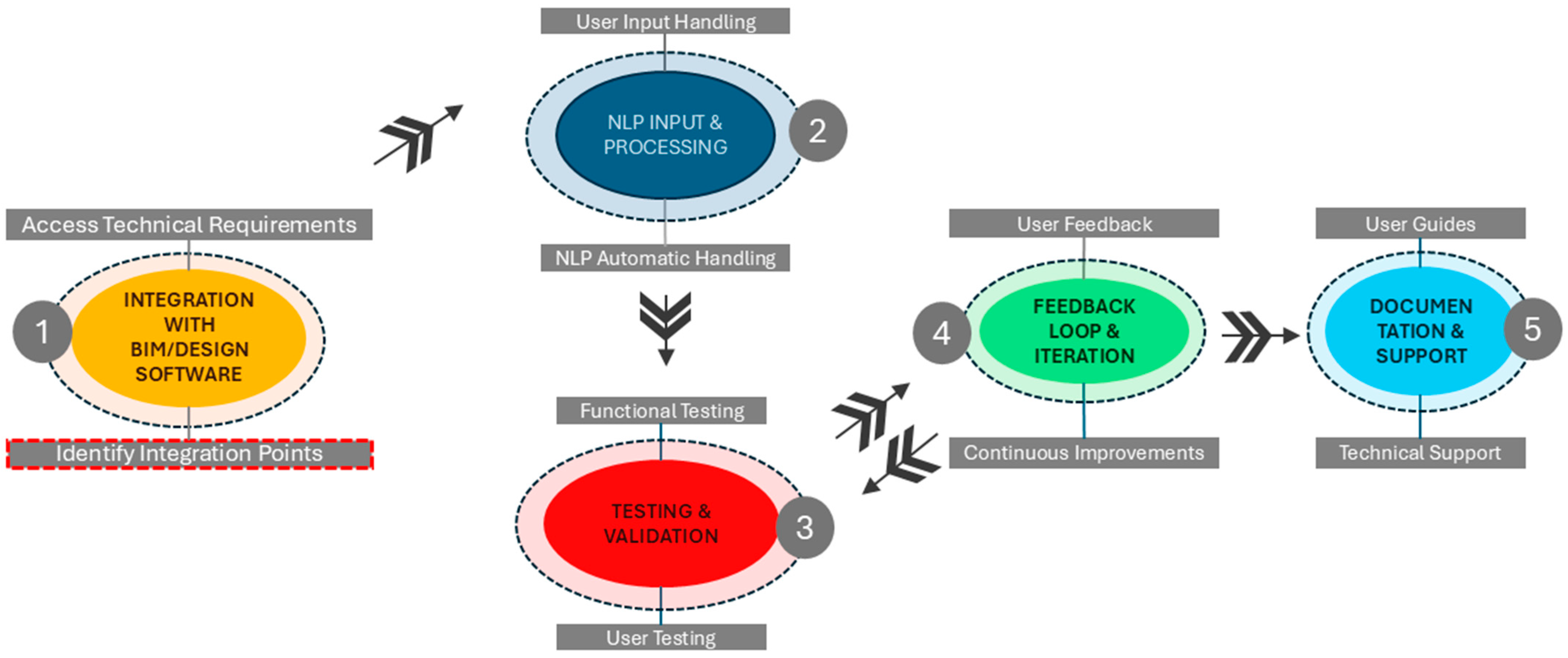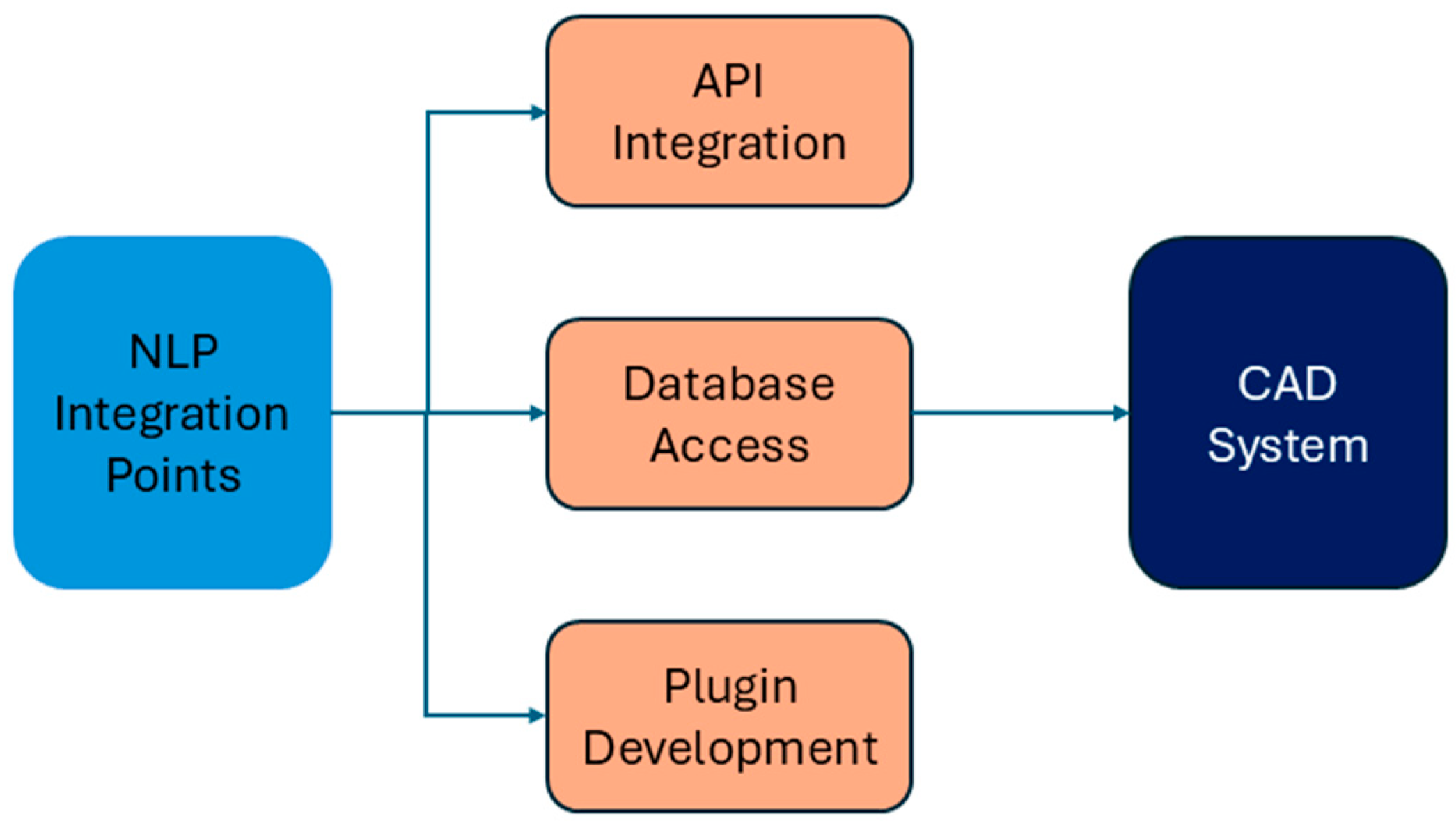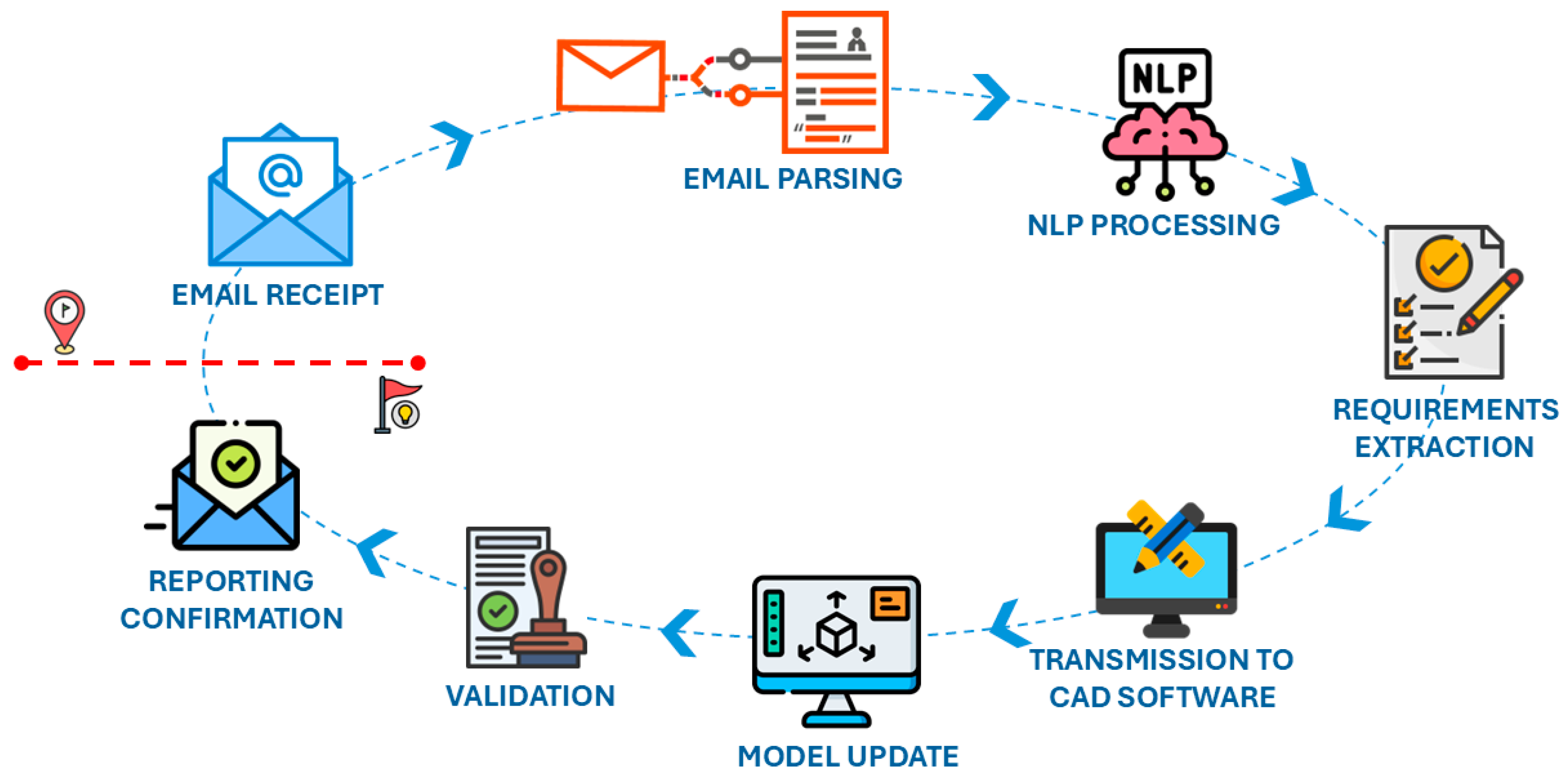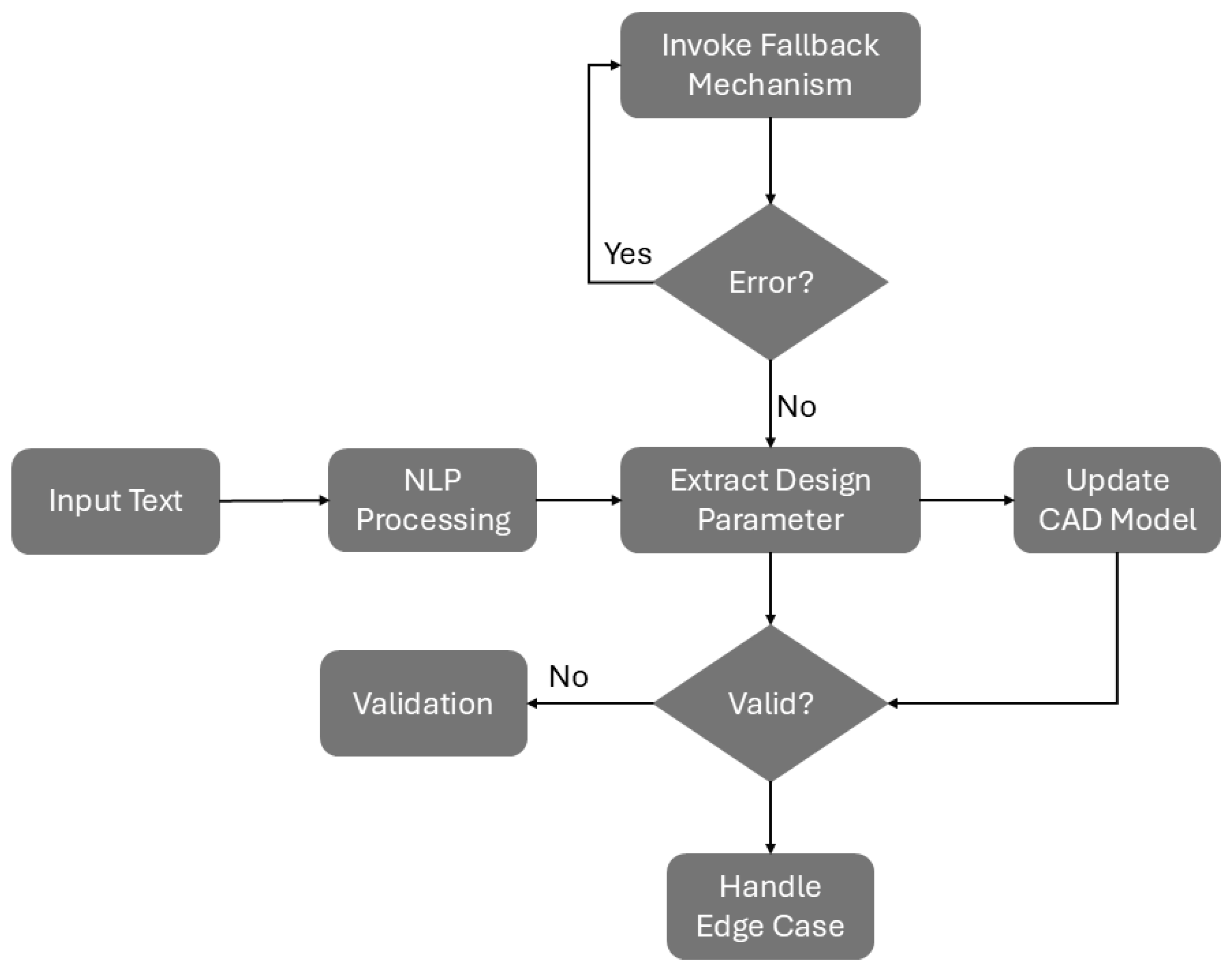An Intelligent Natural Language Processing (NLP) Workflow for Automated Smart Building Design
Abstract
1. Introduction
2. Related Works
3. Methodology
3.1. Proposed Framework Development
3.2. CAD Environment and Tooling
4. Results and Discussion
4.1. Integration Framework Development
4.2. Identifying the Integration Points
4.3. Data Format Standardization in NLP-CAD Integration
4.4. Integration Workflow Example
4.5. Error Handling, Edge Cases, and Validation in the Integration Workflow
4.6. Limitations and Significance of the Framework
5. Conclusions
Author Contributions
Funding
Data Availability Statement
Conflicts of Interest
References
- Okeke, F.O.; Ahmed, A.; Imam, A.; Hassanin, H. A review of corncob-based building materials as a sustainable solution for the building and construction industry. Hybrid Adv. 2024, 6, 100269. [Google Scholar] [CrossRef]
- Okeke, F.O.; Ezema, E.C.; Ibem, E.O.; Sam-amobi, C.; Ahmed, A. Comparative analysis of the features of major green building rating tools (GBRTs): A systematic review. Lect. Notes Civ. Eng. 2025, 539, 355–370. [Google Scholar]
- Alizadehsalehi, S.; Hadavi, A.; Huang, J.C. From BIM to extended reality in AEC industry. Autom. Constr. 2020, 116, 103254. [Google Scholar] [CrossRef]
- Okonta, D.E.; Vukovic, V. Smart cities software applications for sustainability and resilience. Heliyon 2024, 10, e32654. [Google Scholar] [CrossRef]
- Chakrabarty, B.K. Integrated Computer-Aided Design by Optimization: An Overview. In Integrated CAD by Optimization: Architecture, Engineering, Construction, Urban Development and Management; Springer: Cham, Switzerland, 2022; pp. 1–49. [Google Scholar] [CrossRef]
- Mba, E.J.; Okeke, F.O.; Igwe, A.E.; Ebohon, O.J.; Awe, F.C. Changing needs and demand of clients vs ability to pay in architectural industry. J. Asian Archit. Build. Eng. 2025, 15, 1–24. [Google Scholar] [CrossRef]
- Okpalike, C.; Okeke, F.O.; Ezema, E.C.; Oforji, P.I.; Igwe, A.E. Effects of Renovation on Ventilation and Energy Saving in Residential Building. Civ. Eng. J. 2022, 7, 124–134. [Google Scholar] [CrossRef]
- Holmström, J.; Carroll, N. How organizations can innovate with generative AI. Bus. Horiz. 2024, in press. [Google Scholar] [CrossRef]
- Inupakutika, D.; Nadim, M.; Gunnam, G.R.; Kaghyan, S.; Akopian, D.; Chalela, P.; Ramirez, A.G. Integration of NLP and speech-to-text applications with chatbots. Electron. Imaging 2021, 33, 1–6. [Google Scholar] [CrossRef]
- Qiang, G.; Tang, S.; Hao, J.; Di Sarno, L.; Wu, G.; Ren, S. Building automation systems for energy and comfort management in green buildings: A critical review and future directions. Renew. Sustain. Energy Rev. 2023, 179, 113301. [Google Scholar] [CrossRef]
- Sezgin, E.; Hussain, S.A.; Rust, S.; Huang, Y. Extracting medical information from free-text and unstructured patient-generated health data using natural language processing methods: Feasibility study with real-world data. JMIR Form. Res. 2023, 7, e43014. [Google Scholar] [CrossRef]
- Dogan, S. Voice Control and Voice Searching. In Future Tourism Trends Volume 2 (Building the Future of Tourism); Tanrisever, C., Pamukçu, H., Sharma, A., Eds.; Emerald Publishing Limited: Leeds, UK, 2024; pp. 159–172. [Google Scholar] [CrossRef]
- Dweik, W.; Abdalla, M.; AlHroob, Y.; AlMajali, A.; Mustafa, S.A.; Abdel-Majeed, M. Skeleton of implementing voice control for building automation systems. Sci. Program. 2022, 2022, 6886086. [Google Scholar] [CrossRef]
- Olawade, D.B.; Wada, O.Z.; David-Olawade, A.C.; Fapohunda, O.; Ige, A.O.; Ling, J. Artificial intelligence potential for net zero sustainability: Current evidence and prospects. Next Sustain. 2024, 4, 100041. [Google Scholar] [CrossRef]
- Xu, H.; Omitaomu, F.; Sabri, S.; Zlatanova, S.; Li, X.; Song, Y. Leveraging generative AI for urban digital twins: A scoping review on the autonomous generation of urban data, scenarios, designs, and 3D city models for smart city advancement. Urban Inform. 2024, 3, 29. [Google Scholar] [CrossRef]
- Jung, S.Y. Augmenting Deep Learning for Human-Centered Artificial Intelligence. Ph.D. Thesis, National Yang Ming Chiao Tung University, Hsinchu, Taiwan, 2022. Available online: https://www.proquest.com/openview/753dd7e6d315448d3f3bf1a8a2d3bc93/1?cbl=2026366&diss=y&pq-origsite=gscholar (accessed on 25 August 2024).
- Farooqui, A.; Bengtsson, K.; Falkman, P.; Fabian, M. Towards data-driven approaches in manufacturing: An architecture to collect sequences of operations. Int. J. Prod. Res. 2020, 58, 4947–4963. [Google Scholar] [CrossRef]
- Cerquitelli, T.; Pagliari, D.J.; Calimera, A.; Bottaccioli, L.; Patti, E.; Acquaviva, A.; Poncino, M. Manufacturing as a Data-Driven Practice: Methodologies, Technologies, and Tools. Proc. IEEE 2021, 109, 399–422. [Google Scholar] [CrossRef]
- Czvetkó, T.; Kummer, A.; Ruppert, T.; Abonyi, J. Data-driven business process management-based development of Industry 4.0 solutions. CIRP J. Manuf. Sci. Technol. 2022, 36, 117–132. [Google Scholar] [CrossRef]
- Olivetti, E.A.; Cole, J.M.; Kim, E.; Kononova, O.; Ceder, G.; Han, T.Y.-J.; Hiszpanski, A.M. Data-driven materials research enabled by natural language processing and information extraction. Appl. Phys. Rev. 2020, 7, 041317. [Google Scholar] [CrossRef]
- Shah, V. Advancements in deep learning for natural language processing in software applications. Int. J. Comput. Sci. Technol. 2020, 4, 45–56. [Google Scholar]
- Wu, C.; Li, X.; Guo, Y.; Wang, J.; Ren, Z.; Wang, M.; Yang, Z. Natural language processing for smart construction: Current status and future directions. Autom. Constr. 2022, 134, 104059. [Google Scholar] [CrossRef]
- Di Giuda, G.M.; Locatelli, M.; Schievano, M.; Pellegrini, L.; Pattini, G.; Giana, P.E.; Seghezzi, E. Natural Language Processing for Information and Project Management. In Digital Transformation of the Design, Construction and Management Processes of the Built Environment; Springer: Cham, Switzerland, 2019; pp. 95–102. [Google Scholar] [CrossRef]
- Nabavi, A.; Ramaji, I.J.; Sadeghi, N.; Anderson, A.J. Leveraging Natural Language Processing for Automated Information Inquiry from Building Information Models. J. Inf. Technol. Constr. 2023, 28, 266–285. [Google Scholar] [CrossRef]
- Gupta, R.; Kondapally, R.; Guha, S. Large-Scale Information Extraction from Emails with Data Constraints. In Lecture Notes in Computer Science; Springer: Cham, Switzerland, 2019; pp. 124–139. [Google Scholar] [CrossRef]
- Mahlawi, A.Q.; Sasi, S. Structured Data Extraction from Emails. In Proceedings of the 2017 International Conference on Networks & Advances in Computational Technologies (NetACT), Thiruvananthapuram, India, 20–22 June 2017; pp. 323–328. [Google Scholar] [CrossRef]
- Schmitt, X.; Kubler, S.; Robert, J.; Papadakis, M.; Letraon, Y. A Replicable Comparison Study of NER Software: StanfordNLP, NLTK, Opennlp, Spacy, Gate. In Proceedings of the Sixth International Conference on Social Networks Analysis, Management and Security (SNAMS), Granada, Spain, 22–25 October 2019; IEEE: Piscataway, NJ, USA, 2019. Available online: https://mpapad.github.io/publications/pdfs/SNAMS2019.pdf (accessed on 20 August 2024).
- Rogers, A.; Gardner, M.; Augenstein, I. QA Dataset Explosion: A Taxonomy of NLP Resources for Question Answering and Reading Comprehension. ACM Comput. Surv. 2022, 55, 1–45. [Google Scholar] [CrossRef]
- Zulkarnain; Putri, T.D. Intelligent transportation systems (ITS): A systematic review using a Natural Language Processing (NLP) approach. Heliyon 2021, 7, e08615. [Google Scholar] [CrossRef]
- Huang, J.; Johanes, M.; Kim, F.C.; Doumpioti, C.; Holz, G.-C. On GANs, NLP and Architecture: Combining Human and Machine Intelligences for the Generation and Evaluation of Meaningful Designs. Technol. Archit. Des. 2021, 5, 207–224. [Google Scholar] [CrossRef]
- Wang, N.; Issa, R.R.A.; Anumba, C.J. NLP-Based Query-Answering System for Information Extraction from Building Information Models. J. Comput. Civ. Eng. 2022, 36, 04022008. [Google Scholar] [CrossRef]
- Zhou, Y.; She, J.; Huang, Y.; Li, L.; Zhang, L.; Zhang, J. A Design for Safety (DFS) Semantic Framework Development Based on Natural Language Processing (NLP) for Automated Compliance Checking Using BIM: The Case of China. Buildings 2022, 12, 780. [Google Scholar] [CrossRef]
- Zhao, L.; Alhoshan, W.; Ferrari, A.; Letsholo, K.J.; Ajagbe, M.A.; Chioasca, E.-V.; Batista-Navarro, R.T. Natural Language Processing for Requirements Engineering. ACM Comput. Surv. 2021, 54, 1–41. [Google Scholar] [CrossRef]
- Fischbach, J.; Frattini, J.; Vogelsang, A.; Mendez, D.; Unterkalmsteiner, M.; Wehrle, A.; Henao, P.R.; Yousefi, P.; Juricic, T.; Radduenz, J.; et al. Automatic creation of acceptance tests by extracting conditionals from requirements: NLP approach and case study. J. Syst. Softw. 2023, 197, 111549. [Google Scholar] [CrossRef]
- Chowdhary, K.R. Natural Language Processing. In Fundamentals of Artificial Intelligence; Springer: New Delhi, India, 2020; pp. 603–649. [Google Scholar] [CrossRef]
- Vajjala, S.; Majumder, B.; Gupta, A.; Surana, H. Practical Natural Language Processing: A Comprehensive Guide to Building Real-World NLP Systems; O’Reilly Media, Inc.: Sebastopol, CA, USA, 2020; Available online: https://books.google.com.ng/books?hl=en&lr=&id=hvrrDwAAQBAJ&oi=fnd&pg=PP1&dq=Ensure+that+the+NLP+integration+performs+as+expected+across+various+scenarios+and+user+inputs&ots=gsew8n0_fe&sig=OAq16KP-Y-NhdboHZJzdVAVYsQE&redir_esc=y (accessed on 20 August 2024).
- Cejas, O.A.; Azeem, M.I.; Abualhaija, S.; Briand, L.C. NLP-based automated compliance checking of data processing agreements against GDPR. IEEE Trans. Softw. Eng. 2023, 49, 4282–4303. [Google Scholar] [CrossRef]
- Shaik, T.; Tao, X.; Li, Y.; Dann, C.; McDonald, J.; Redmond, P.; Galligan, L. A Review of the Trends and Challenges in Adopting Natural Language Processing Methods for Education Feedback Analysis. IEEE Access 2022, 10, 56720–56739. [Google Scholar] [CrossRef]
- Mustansir, A.; Shahzad, K.; Malik, M.K. Towards automatic business process redesign: An NLP based approach to extract redesign suggestions. Autom. Softw. Eng. 2022, 29, 1–35. [Google Scholar] [CrossRef]
- Raharjana, I.K.; Siahaan, D.; Fatichah, C. User stories and natural language processing: A systematic literature review. IEEE Access 2021, 9, 53811–53826. [Google Scholar] [CrossRef]
- Pais, S.; Cordeiro, J.; Jamil, M.L. NLP-based platform as a service: A brief review. J. Big Data 2022, 9, 54. [Google Scholar] [CrossRef]
- Locatelli, M.; Seghezzi, E.; Pellegrini, L.; Tagliabue, L.C.; Di Giuda, G.M. Exploring Natural Language Processing in Construction and Integration with Building Information Modeling: A Scientometric Analysis. Buildings 2021, 11, 583. [Google Scholar] [CrossRef]
- Bennett, T. Direct Database Access vs. REST APIs: Compare Application Activity. DreamFactory Blog. Available online: https://blog.dreamfactory.com/direct-database-access-vs-rest-apis-pros-and-cons-for-application-connectivity/#:~:text=Direct%20database%20access%20and%20REST%20APIs%20differ (accessed on 18 August 2024).
- Tuama, D.Ó. What Is a Plugin? Code Institute Global. Available online: https://codeinstitute.net/global/blog/what-is-a-plugin/ (accessed on 23 June 2024).
- Denissov, N. Creating an Educational Plugin to Support Online Programming Learning A Case of IntelliJ IDEA Plugin for A+ Learning Management System. Master’s Thesis, Aalto University, Espoo, Finland, 2021. Available online: https://aaltodoc.aalto.fi/items/7b9aa893-9614-4ac8-84a3-58f8a6c832eb (accessed on 22 June 2024).
- Saad, A.; Ajayi, S.O.; Alaka, H.A. Trends in BIM-based plugins development for construction activities: A systematic review. Int. J. Constr. Manag. 2022, 23, 2756–2768. [Google Scholar] [CrossRef]
- Oti, A.H.; Tizani, W.; Abanda, F.H.; Jaly-Zada, A.; Tah, J.H.M. Structural sustainability appraisal in BIM. Autom. Constr. 2016, 69, 44–58. [Google Scholar] [CrossRef]
- Murali, A. What Is API Deprecation & Its Guidelines. Document360 Blog. Available online: https://document360.com/blog/api-deprecation/ (accessed on 1 May 2024).
- Afsari, K.; Eastman, C.; Shelden, D. Building Information Modeling data interoperability for Cloud-based collaboration: Limitations and opportunities. Int. J. Archit. Comput. 2017, 15, 187–202. [Google Scholar] [CrossRef]
- Moretti, N.; Xie, X.; Merino, J.; Brazauskas, J.; Parlikad, A.K. An openBIM Approach to IoT Integration with Incomplete As-Built Data. Appl. Sci. 2020, 10, 8287. [Google Scholar] [CrossRef]
- Sobernig, S.; Gaubatz, P.; Strembeck, M.; Zdun, U. Comparing complexity of API designs. ACM SIGPLAN Not. 2012, 47, 157–166. [Google Scholar] [CrossRef]
- Nolst Trenité, T. Simplifying the Complex: Strategies to Reduce Existing API Complexity Using CPS Techniques. Master’s Thesis, Utrecht University, Utrecht, The Netherlands, 2023. Available online: https://studenttheses.uu.nl/handle/20.500.12932/44009 (accessed on 15 September 2024).
- Du, J.; Zou, Z.; Shi, Y.; Zhao, D. Zero latency: Real-time synchronization of BIM data in virtual reality for collaborative decision-making. Autom. Constr. 2018, 85, 51–64. [Google Scholar] [CrossRef]
- Antonopoulos, P.; Arasu, A.; Singh, K.D.; Eguro, K.; Gupta, N.; Jain, R.; Kaushik, R.; Kodavalla, H.; Kossmann, D.; Ogg, N.; et al. Azure SQL Database Always Encrypted. In Proceedings of the 2020 ACM SIGMOD International Conference on Management of Data, Portland, OR, USA, 14–19 June 2020. [Google Scholar] [CrossRef]
- Reimann, P.; Schwarz, H.; Mitschang, B. Design, implementation, and evaluation of a tight integration of database and workflow engines. J. Inf. Data Manag. 2011, 2, 353. [Google Scholar]
- Nikolov, N.; Dessalk, Y.D.; Khan, A.Q.; Soylu, A.; Matskin, M.; Payberah, A.H.; Roman, D. Conceptualization and scalable execution of big data workflows using domain-specific languages and software containers. Internet Things 2021, 16, 100440. [Google Scholar] [CrossRef]
- Wu, S.; Shen, Q.; Deng, Y.; Cheng, J. Natural-language-based intelligent retrieval engine for BIM object database. Comput. Ind. 2019, 108, 73–88. [Google Scholar] [CrossRef]
- Ignatova, E.; Zotkin, S.; Zotkina, I. The extraction and processing of BIM data. IOP Conf. Ser. Mater. Sci. Eng. 2018, 365, 062033. [Google Scholar] [CrossRef]
- Aydin, C. Best Revit Plugins: Enhancing Efficiency in BIM Workflows. Project Cubicle. Available online: https://www.projectcubicle.com/best-revit-plugins-enhancing-efficiency-in-bim-workflows/ (accessed on 18 August 2024).
- Abbasnejad, B.; Moeinzadeh, S.; Ahankoob, A.; Wong, P.S.P. The Role of Collaboration in the Implementation of BIM-Enabled Projects. In Handbook of Research on Driving Transformational Change in the Digital Built Environment; IGI Global: Hershey, PA, USA, 2021; pp. 1–36. [Google Scholar] [CrossRef]
- Atik, S.; Doménech, T.; Raslan, R. The Opportunities and Challenges of Using LCA-Based BIM Plugins in Early-Stage Building Design: An Industry Expert Perspective. In Proceedings of the APAC Conference on Sustainable Built Environment, Kandy, Sri Lanka, 16–18 December 2022; Springer: Singapore, 2022; pp. 401–408. [Google Scholar] [CrossRef]
- Narkhede, S. What Is an SDK? (Definition, Benefits, vs. API, Uses). Builtin 2022. Available online: https://builtin.com/software-engineering-perspectives/sdk (accessed on 5 August 2024).
- Kazado, D.; Kavgic, M.; Eskicioglu, R. Integrating Building Information Modeling (BIM) and sensor technology for Facility Management. J. Inf. Technol. Constr. 2019, 24, 440–458. [Google Scholar]
- Song, J.; Kim, J.; Lee, J.K. NLP and deep learning-based analysis of building regulations to support automated rule checking system. In Proceedings of the 35th International Symposium on Automation and Robotics in Construction, Berlin, Germany, 20–25 July 2018; pp. 586–592. [Google Scholar] [CrossRef]




| Step | Objective | Methods/Procedures | Tools/Techniques | Data Collection | Rationale |
|---|---|---|---|---|---|
| 1. Data Extraction and Processing | Extract relevant design requirements from natural language inputs. | - Collect unstructured text inputs (e.g., client briefs, emails). - Use NLP tools to parse text and identify key design parameters. - Structure extracted data in machine-readable formats (JSON, XML). | NLP libraries: spaCy, NLTK data structuring: JSON, XML | Sample project briefs, case studies, simulated client inputs | Provides foundational data required for all downstream processing. |
| 2. Integration Framework Development | Develop seamless communication between NLP tools and CAD systems. | - Analyze CAD systems (e.g., Revit, AutoCAD) for integration points. - Develop APIs or plugins to connect NLP output with CAD input. - Implement middleware for data translation and command execution. | APIs (RESTful services), Autodesk Forge, Revit API, Python | CAD system documentation, API testing logs | Establishes the infrastructure to connect data extraction with design tools. |
| 3. Automated Design Integration | Automate real-time updates in CAD models based on structured design inputs. | - Transmit structured data from NLP tools to CAD software. - Automate model updates based on received parameters. - Perform validation checks to ensure compliance with design standards and codes. | JSON data exchange Automated CAD scripts Compliance check routines | CAD model audit reports, compliance verification data | Translates integrated data into automated design actions in the CAD environment. |
| 4. Testing and Validation | Test functionality and validate accuracy of system components and integration. | - Conduct unit tests on NLP modules. - Perform integration testing between NLP and CAD systems. - Facilitate user testing sessions with architects and designers. - Collect feedback on usability and effectiveness. | Unit and integration testing User testing Surveys/interviews | System performance metrics, user feedback surveys, testing logs | Verifies technical accuracy and collects feedback on system usability and performance. |
| 5. Feedback Loop and Iteration | Refine system through user feedback and iterative development. | - Collect feedback through surveys and interviews. - Analyze feedback to identify areas for improvement. - Iteratively adjust NLP and CAD integration components. - Conduct multiple testing cycles for refinement. | Thematic analysis Iterative development Agile methodology | User feedback forms, performance improvement logs, iteration reports | Ensures continuous improvement and adaptation to evolving user needs and design scenarios. |
| Integration Points | Advantages | Disadvantages |
|---|---|---|
| APIs (Application Programming Interfaces) | - Enhanced user interaction via an understanding of and responses to natural language queries. This is achieved as APIs create new connections between plugins and software not only through communication but also through database linkages towards enhanced project data extraction [46,47]. - The automation and efficiency of systems in data entry, workflow automation and report generation, establishing a connection between the software and database [46]. - Provide analytics and a contextual understanding and real-time monitoring. | - APIs can be discontinued or specifications changed, allowing for new corresponding adjustments in BIM software, potentially disrupting workflow [48]. - The possibility for APIs to experience latency, as well as rate limits, implies that real-time data synchronization or batch processing capabilities may be hampered [49,50]. - The complexity of integration also exists as the data mapping and transformation process requires an alignment between existing data structures and formats specific to each API variant [51,52]. |
| Direct Database Access | - Provides real-time access and integration via immediate updates as well as compatibility [53]. - Provides avenues for data integrity and consistent supply [54]. - Allows for customization and extensibility via tailored workflows, plugin integration and scalability [55,56]. | - The rapid growth of building components in the BIM object database increases the difficulty of the efficient querying of components that users require [57]. - The risk of data complexity is of paramount importance, as a high dependency on the database structure may lead to a need for corresponding BIM updates [58]. |
| Plugins | - Enhanced Functionalities: Core CAD software now allows for the accurate translation of NLP techniques, offering specialized access to capabilities and tools that are not available out of the box [22]. - Workflow Optimization: Eliminating the requirement for manual data entry reduces the possibility of errors [46,59]. - Specialized tools for disciplines: catering to specialized information in terms of CAD through custom-built plugins is proven to drive productivity and efficiency towards cost and time savings [46]. - Improved collaboration among numerous project stakeholders to ensure seamless data interchange [60]. - Cost and time savings: lowering the time required for project rework or the project delivery timetable [46,61]. | - Internally, some plugins utilize APIs to communicate with different services for development purposes [62]. - Compatibility issues may arise regarding model data size and unsuitability with early-stage BIM models. Also, compatibility discourse with regard to the lack of sustainability of CAD models exists [61]. - Due to a lack of regulatory enforcement and sectoral motivation, plugins, in most cases, are currently limited to supporting building certification rather than as a part of a design process [61]. - Poor and outdated plugins pose multiple risks, especially due to the fact that they are case-dependent. Hence, they possess an inability to develop 2D data in a specific case into more visualized data that is enhanced by a more practical viewing and searching criterion [63]. |
Disclaimer/Publisher’s Note: The statements, opinions and data contained in all publications are solely those of the individual author(s) and contributor(s) and not of MDPI and/or the editor(s). MDPI and/or the editor(s) disclaim responsibility for any injury to people or property resulting from any ideas, methods, instructions or products referred to in the content. |
© 2025 by the authors. Licensee MDPI, Basel, Switzerland. This article is an open access article distributed under the terms and conditions of the Creative Commons Attribution (CC BY) license (https://creativecommons.org/licenses/by/4.0/).
Share and Cite
Okonta, E.D.; Okeke, F.O.; Mgbemena, E.E.; Nnaemeka-Okeke, R.C.; Guo, S.; Awe, F.C.; Eke, C. An Intelligent Natural Language Processing (NLP) Workflow for Automated Smart Building Design. Buildings 2025, 15, 2413. https://doi.org/10.3390/buildings15142413
Okonta ED, Okeke FO, Mgbemena EE, Nnaemeka-Okeke RC, Guo S, Awe FC, Eke C. An Intelligent Natural Language Processing (NLP) Workflow for Automated Smart Building Design. Buildings. 2025; 15(14):2413. https://doi.org/10.3390/buildings15142413
Chicago/Turabian StyleOkonta, Ebere Donatus, Francis Ogochukwu Okeke, Emeka Ebuz Mgbemena, Rosemary Chidimma Nnaemeka-Okeke, Shuang Guo, Foluso Charles Awe, and Chinedu Eke. 2025. "An Intelligent Natural Language Processing (NLP) Workflow for Automated Smart Building Design" Buildings 15, no. 14: 2413. https://doi.org/10.3390/buildings15142413
APA StyleOkonta, E. D., Okeke, F. O., Mgbemena, E. E., Nnaemeka-Okeke, R. C., Guo, S., Awe, F. C., & Eke, C. (2025). An Intelligent Natural Language Processing (NLP) Workflow for Automated Smart Building Design. Buildings, 15(14), 2413. https://doi.org/10.3390/buildings15142413








